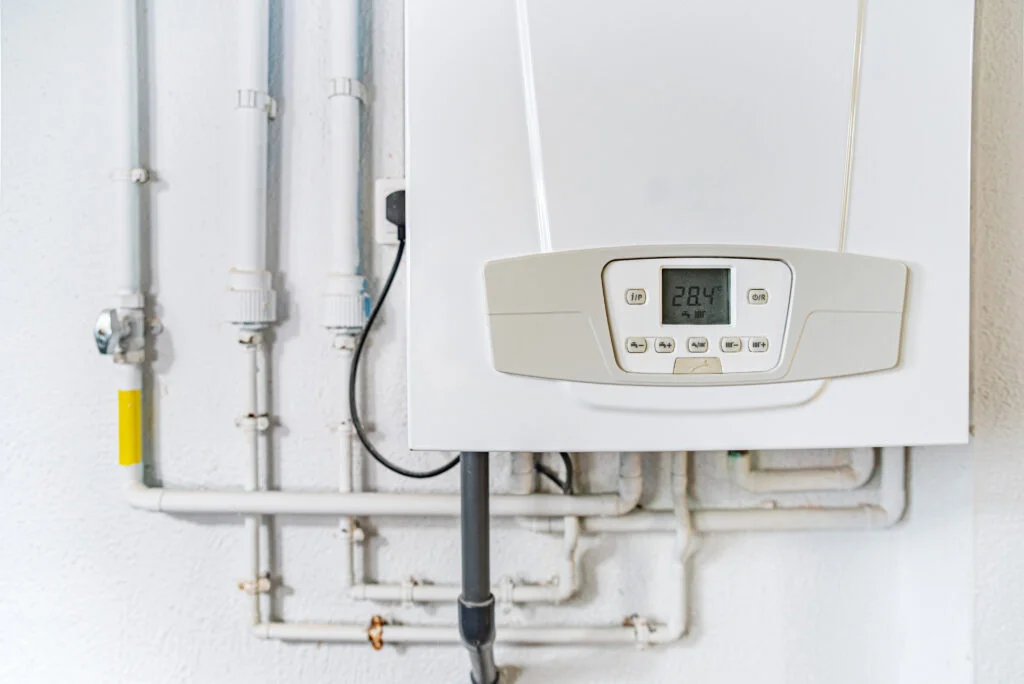Water heaters are among the most indispensable objects in the home. Water heaters play a massive role in our daily lives, whether it’s that refreshing shower or the comforting warmth of dishwater. Yet, a burning question often arises for those considering a new installation: how long does it take to install a water heater?
This comprehensive guide explores different water heater types and factors affecting installation time and provides a step-by-step breakdown. Let’s get started.
How Long Does It Take to Install a Water Heater?
In general, installing a new water heater takes two to three hours, though transitioning from a tank to a tankless system or vice versa may extend this timeframe. If you hire a professional plumber, they’ll carefully remove your old water heater in the first hour. This stage involves draining and disassembling tank water heaters.
After that, it takes around 30 minutes to get your new water heater in place and secured. The precision of this step ensures a swift yet reliable installation. Then, your plumber will hook up your new lines and test to ensure your new water heater works.
They’ll check all the connections for leaks and listen for signs that something’s wrong. Before they leave, they will ensure your water heater is working correctly.
Ensure your water tank is flushed at least once a year to keep mineral buildup at bay. It is crucial to check for leaks to address them immediately. Ensure the water pressure is correct by studying it. Be on the lookout for unusual sounds that may indicate a problem.
Types of Water Heaters
Knowing the different types of water heaters is crucial in choosing one for your home. Each type has its advantages and considerations. Here’s a brief overview of the main types:
1. Tankless Water Heaters
On-demand water heaters, or tankless water heaters, provide hot water when needed. The system doesn’t store water. Instead, it heats it on demand, so it’s energy-efficient, and you get endless hot water. It may take a bit longer to install because of the unique features of this system.
Installing a tankless water heater typically takes around 2 to 4 hours. The variability is determined by factors such as the complexity of the adjustments required for on-demand heating.
2. Storage Tank Water Heaters
The most common type is storage tank water heaters, which store and preheat a large amount of water. They ensure a steady hot water supply but may be less energy-efficient than tankless options. Typically, the installation process involves draining the old tank before replacing it.
Traditional storage tank water heaters are usually installed in two to three hours. In many cases, the familiarity of this type streamlines the installation process.
3. Heat Pump Water Heaters
Heat pumps extract heat from the air or ground to heat water. They’re energy-efficient, but external temperatures can affect them. The heat pump system may require additional considerations during installation.
Heat pump water heaters require between three and five hours to install. Additional considerations for the heat pump system make the process take longer.
Understanding these types’ differences is essential to make an informed decision. We’ll dig into the factors affecting installation time in the following sections.
Now you better understand how long it takes to install a water heater.
Factors Affecting Installation Time
There is no one-size-fits-all duration for water heater installation. Several factors influence the time it takes to complete the installation process. The following are key factors to consider:
Type of Water Heater Chosen
There are different installation requirements for different types of water heaters. Due to their on-demand heating system, tankless water heaters, for example, may take longer. For accurate time estimates, it is essential to understand the nuances of your chosen type.
Location for Installation
Where you plan to install the water heater matters. If it’s a straightforward replacement in an easily accessible location, the process may be quicker. However, installations in tight or hard-to-reach spaces could extend the timeframe.
Existing Plumbing Setup
The condition and layout of your existing plumbing system play a significant role. Installing a tankless system after upgrading from a storage tank may require adjustments to the plumbing.
Local Regulations and Permits
Obtaining necessary permits and complying with local building codes can affect installation in Dallas, Texas. Ensuring that the installation meets regulatory standards is crucial, even if it takes a little longer.
Considering these factors will help you better understand the variables that affect installation time.
Tips for a Smooth Installation
Planning and proactive measures are essential to a smooth water heater installation. Follow these tips to enhance your installation experience:
Hiring a Professional Plumber
A professional plumber can play a crucial role in water heater installations in Dallas, Texas. Their experience ensures a smooth installation and the ability to handle unexpected challenges.
Professional plumbers can assess your situation, recommend the right water heater, and install it perfectly. In addition to saving you time, it gives you peace of mind knowing the installation is in good hands.
So, if you are starting a water heater installation project in Dallas, Texas you should look for a reliable plumber.
Read More: Comparing Two Different Water Heater Companies
Planning for Potential Challenges
Planning is the first step to a well-prepared installation. Remove any obstacles that could hinder access to the installation site. Install the water heater where the plumber has easy access and plenty of room.
Communicate any unique aspects of your home’s plumbing system in advance so the plumber can prepare. The proactive approach minimizes the chances of unexpected delays and ensures an efficient installation.
Read More: Water Heater Installation: How to Avoid Getting Ripped Off
Regular Maintenance for Longevity
Regular maintenance is critical to ensuring a water heater’s long-term performance. Consider incorporating the following practices into your routine:
- Annual Tank Flushing: Minerals and sediment can accumulate in tanks over time, reducing efficiency. Maintaining optimal performance requires flushing the tank annually to prevent buildup.
- Leak Checks: Ensure all connections and valves are regularly inspected for leaks. Preventing water damage and ensuring the system’s integrity depends on addressing leaks promptly.
- Water Pressure Monitoring: Follow the manufacturer’s recommendations for adjusting the water pressure. Excessive pressure can cause problems with the water heater.
- Listen for Unusual Sounds: Listen for unusual sounds from the water heater. You might hear popping or rumbling noises from sediment buildup, or you might listen to mechanical noises. Early detection makes it easier to intervene when it’s too late.
Your water heater will last longer and perform more reliably if you follow these maintenance and installation tips.
The Takeaway
Water heater installation requires vital considerations, from choosing the right type to understanding installation times and embracing proactive measures. Plan and prioritize regular maintenance with the help of a professional plumber to reduce long-term costs. Professional installation ensures a seamless process and empowers homeowners to maintain optimal performance.


